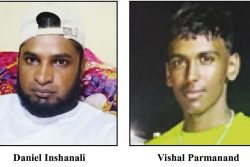In a blunt statement in response to a column in the Guyana Chronicle by presidential advisor on the environment, Rear Admiral (ret’d) Gary Best, the Director of Norway’s International Climate and Forest Initiative, Per Pharo has set out in stark terms what decisions have to be made by the government here to access monies accrued under the 2009 forest protection partnership.
The government here has not been forthcoming about the challenges facing the pact with Norway. Mr Pharo had no qualms about saying that since the change of government in May 2015, several public statements have created doubts about whether the APNU+AFC government is committed to the goals of the previous administration’s Low Carbon Development Strategy (LCDS) and which formed the basis of the agreement between the two countries. In particular, he cited the commitment for Guyana’s transition to near 100 percent clean and renewable energy sources by 2025.
This, Mr Pharo said, made a “pause in the implementation of our partnership necessary. We strongly defend the right of a government to set the development path of its country. But if that development path were to deviate from that which was the basis for our partnership, then it is not the right of a government to retain the benefits of a partnership based on commitments it no longer intends to fulfil”.
He said it is for this reason while it awaits clarification from the Granger administration that Oslo has not been in a position to make any new financial transfers or commitments to the partnership.
“We are currently awaiting an announced plan for a concrete, realistic and cost effective transition to clean and renewable energy in line with Guyana’s (Intended Nationally Determined Contributions) INDC and the spirit of our partnership”, Mr Pharo said.
The monies in question are US$40m for results achieved under the partnership for the year 2013 and US$80m which had been deposited with the Inter-American Development Bank for use as Guyana’s equity contribution for the planned Amaila Falls Hydropower Project (AFHP).
As has been stated before, the Granger administration has the right to decide whether its green energy objectives coincide with those enshrined in the agreement between the PPP/C government and Norway in 2009. If it is unhappy with the contours of the PPP/C’s LCDS then it must present its own plan otherwise it risks losing access to US$120m and international climate goodwill. The government has set out to dispute the findings of the December 12, 2016 Norconsult report which was intended as a final verdict on the feasibility of the AFHP. That report stated that the AFHP was the fastest way forward for Guyana to realize its green energy ambitions. Aside from hydropower being the best green energy project for the country, the Norconsult report pinpointed Amaila as the best hydropower prospect. The government is now evidently at crossroads in its relationship with Norway.
As in many other areas of its governance, the Granger administration appears paralysed and lethargic. It’s 2017 budget made reference to a number of worthy solar energy projects for Mabaruma, Lethem, Bartica and Mahdia. However, thus far nothing has been presented that compares with the scale and scope of what the flawed AFHP promised. Despite the fact that it has had two years in office and much preparation prior to that, the Granger administration has been woefully unable to put together a green energy plan that would show serious intent. It has to snap out of its stupor and come up with a plan.
The hiatus in the relationship with Norway is but a microcosm of a larger malady on the way forward for the country. While there is understandably elaborate discussion about the plans for oil production in four or five years and a continuous stream of consultants and suitors for Guyana’s oil industry – and no doubt many fly-by-nighters – the Granger administration has shown no inclination to spark the much broader discussion that must begin on the country’s future.
It must immediately begin preparing the framework for what the economy should look like 10 years following the first oil and how to get there with all shoulders to the wheel. Where are the beginnings of a national plan involving both the government and the opposition and all other stakeholders on how oil revenues should be employed to transform the economic bases of the country and to ensure continuous job creation, light manufacturing and development of services that could be provided to wealthy economies? Should oil revenues also be utilized in fulfilling the long-held dream of Guyana becoming the bread basket for the Caribbean and to meeting domestic needs? This would require expert analysis of the needs of the market matched to cultivable areas along the coast and aligned with the required transportation.
With the sugar industry in dire straits and hundreds of jobs already lost and many more at grave risk, the APNU+AFC administration should have already begun the orchestration of a national plan for the oil economy encompassing all stakeholders. How should the sugar belt be redeployed? What skills sets would mesh with the future development plans for the country? Unfortunately, the administration appears to be entirely seized with the prospect of ensuring its re-election in 2020 and deploying its energies in the SOCUs and SARUs, inquiries and commissions -all signs of an absence of vision and an enrapturing with political power.
While Guyana could be on the cusp of its biggest development spurt ever, it is one that is rife with risks if not properly managed and if the country remains deeply cleft along political and ethnic lines. Those divisions will not be easily straddled but a plan for what Guyana should look like in 2025 where each and every citizen regardless of political affiliation is aware of the direction of the economy and how they fit in to its planning would be of inestimable value and bring its own dynamics. There is no sign of any such thinking by this government or intended inclusion of the opposition and all other stakeholders in such an enterprise. The inchoate oil industry has brought the country to a bewildering crossroads fraught with as many pitfalls as opportunities. The government must show itself as prepared to oversee the determination of the best pathways rather than dictating the course.








